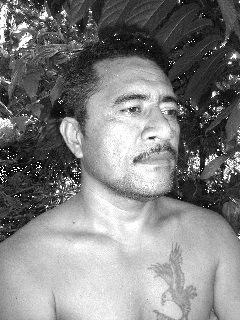Wilson Fitiao is a Samoan born on Upolu Island, Samoa and raised on Tutuila Island, American Samoa. He has struggled to survive in the local community as an artist respecting his Samoan heritage as well as himself - an individual in present day American Samoa.
This indeed is a tall order in a society that reveres mastery in its cultural context - mea sina a Samoa (the Samoan cultural heritage) - as creativity. In this sense, the individual becomes a master (tufuga) only when he has shown his work to "correctly" or "truthfully" or "respectfully" communicate the fa'aSamoa (the Samoan way).
Wilson began his journey as an artist while attending Faga'itua High School in the Eastern District of Tutuila Island. He laughingly recalls, "Art was the only subject I got an A in. At that time I was always drawing fales (traditional Samoan houses), fish; you know...the usual stuff. And then I met Mary Pritchard*. She was there to teach siapo (Samoan tapa).".
Wilson describes his classes with Mary Pritchard as one of the cornerstones of his artistic journey. "She opened up a whole new world for me! She is definitely my idol!" Mary Pritchard gave Wilson his first taste of Samoan symbols and patterns. The excitement this experience engendered can still be heard in Wilson's voice today. "I had no idea, until Mary Pritchard, our culture had these symbols and patterns that are ours - Samoan! Before that I was just drawing."
After high school, Wilson talks about a period in his life that was a personal struggle. "How do you survive as an artist here? There is no help from the government (scholarships). No programs to encourage you. How do you make a living? Gotta eat!"
In a sense, his solution was a natural. Wilson taught himself the skill of skin art - or tattooing. "I saw this older guy doing a tattoo (for money) at my cousin Tisa's place (Tisa's Barefoot Bar). I said to myself, 'I can do that. And I know my designs are better!'" Today Wilson supports his life's journey by doing tattoos - tapu vae (ankle bands), tapu lima (arm and wrist bands), as well as other designs. He is well known in the local community for the creativity he's brought to the local skin art. Which makes the next step he took an intrinsic step.
 |
Wilson decided to learn Samoan tattooing the Samoan way - through apprenticeship with a tufuga tatatau (Master tattooer of the Samoan full body tattoo). "I wanted to learn from a master, someone who belonged to a clan known for their tattoos and known for their mastery. So I went to Suluape Lafaele two years ago. He is the youngest of the Suluape clan, who are well known for their work."
He notes, "The first thing I was told to do, if I wanted to become his apprentice, was to cut my hair. I had a rasta style. Believe me that was a sacrifice! I still have some people who don't recognize me now. But it's been worth it!" It was Wilson's first experience of the respect that is perceived as an integral part of 'la ei Samoa' (heritage). The next stage was to observe. "For the next three months I helped him light his cigarette and watched. A very humbling experience. I was told to do nothing else. My pride really took a blow. But I knew this was the right way." |
Wilson also submitted to a full body Samoan tattoo and is now a sogaimiti (able to serve chiefs and family formally). It took him eight (8) days. "It was very painful. But worth it. I learned about courage and patience." It has been a great journey and there is more to come.
It is part of what has allowed Wilson to say with certainty and pride, "I am a Samoan artist. I have respect for the patterns; these patterns that have spoken to us from generation to generation. They talk from the sea, the earth, the sky and are ancient as our thoughts. I am an artist."
Tufuga and artist have become interchangeable in Wilson's vocabulary. They are what he is constantly striving to be. "I always give respect to the siapo and tattoo patterns by always working with them in my work. They define my work as Samoan. But I am constantly changing, so they change with me."
Today, Wilson continues his learning process. He has earned the right to own some of the traditional tattooing tools, i.e. the au mogo , the au tapulu and the au sogiaso. And, he is on call for any tattooing event his teacher, Master (tufuga) calls him to attend. Also, he is still doing tattoos upon request, for a fee.
And finally, Wilson is putting together art pieces for a major show sometime in the near future. His pieces vibrantly communicate their creator's concepts of heritage, culture and individuality.
Wilson Fitiao is an artist. He is a Samoan.
* (Mary Pritchard was a master of siapo (Samoan tapa). Her tapa works of 'siapo mamanu' (commonly known as freehand tapa) are perceived locally as Samoan masterpieces.
